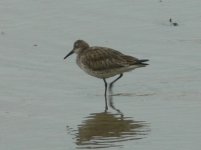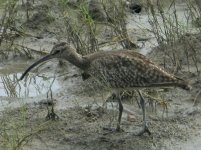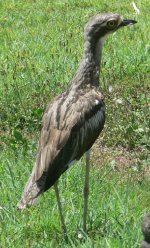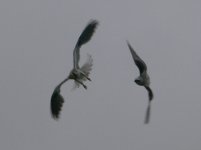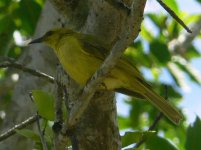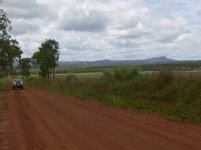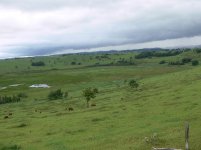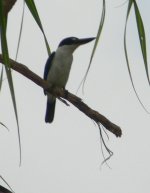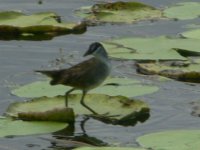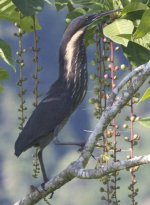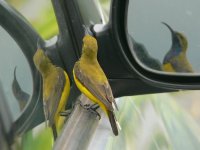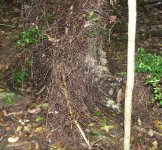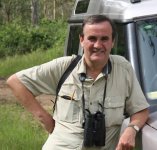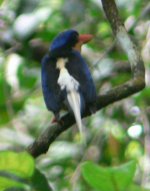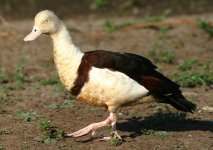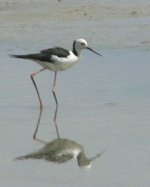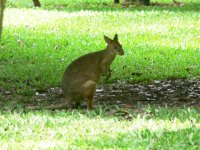John Cantelo
Well-known member
Thursday 9th December
Cassowary House – Cairns Esplanade – Cairns Cemetery
Rain in the morning dampened my enthusiasm for an early morning perambulation, but once it cleared we were off to Cairns for a spot of shopping. And, oh yes, a look at the famous esplanade! As expected this meant a lot of lifers for relatively little effort (just how I like it) for yours truly. So it’s time for another list – Striated Heron, Eastern Reef Egret, Australian Pelican, Royal Spoonbill, Crested Tern, Eastern Curlew, Grey-tailed Tattler, Great Knot, Red-necked Stint, Lesser Sandplover and Silver Gull. Lifers all and even the non-lifers weren’t to be sneezed at since they included Sharp-tailed and Terek Sandpipers. If you’ve read this far then you can probably guess that the birds that stood out for me were those species that are vagrants in the UK: Lesser and Greater Sandplovers (different bill size was obvious with the races involved here), Grey-tailed Tattler and Great Knot. Of almost equal importance to me was the opportunity to get good views of variegatus Whimbrel largely to confirm that the bird I saw years ago at Reculver was indeed a hudsonius.! Away from the immediate foreshore I also tallied Rainbow Lorikeet, White-breasted Cuckoo-shrike and Brown Honeyeater, but, despite persistent peering into the mangroves, I only heard both Mangrove Robin and Collared Kingfisher.
By now the number of ‘heard only’ species – thanks partly to Phil’s keen ears and encyclopaedic knowledge and partly my own incompetence – was reaching embarrassing levels. In addition to those noted above I’d also only heard; Cicadabird (daily!), Fairy Gerygone, Noisy Pitta, Chowchilla, Varied Honeyeater, Mangrove Robin and Lesser Sooty Owl. Of these only the owl was really forgivable as, Phil told me, they are never seen in daylight and getting one really needed a ‘spot lighting expedition’. The most seriously embarrassing omission, though, was Varied Honeyeater. Phil had heard them calling along the promenade and had directed me towards them. I, toddling off with camera in hand, had seen an unfamiliar honeyeater and taken a few snaps. It was only an hour or more later that I looked at my efforts and the penny dropped – it was a lifer alright, but a Brown Honeyeater not a Varied one. Oops!
In a day of many highlights (and once again of many lifers) one stood out: Bush Stone-curlew. Although I’d seen a couple earlier in the day, it was a meander around the municipal graveyard that gave me real ‘sit-up-and-beg’ views. Used to the elusive and rural nature of ‘our’ Stone-curlew, it was a shock to see these fellows strutting around so confidently in an urban setting. A shock too was their impossibly attenuated bodies with legs up to the elbows – think “stone-curlew, Parisian catwalks and size zero” and you’ll know what they look like! Incidentally, having stood with both profiles neatly aligned for a little while the instant I clicked the shutter the Lesser Sand-plover in the photo turned away from me! Pity as the contrast in the two bills was really obvious - honest!
Cassowary House – Cairns Esplanade – Cairns Cemetery
Rain in the morning dampened my enthusiasm for an early morning perambulation, but once it cleared we were off to Cairns for a spot of shopping. And, oh yes, a look at the famous esplanade! As expected this meant a lot of lifers for relatively little effort (just how I like it) for yours truly. So it’s time for another list – Striated Heron, Eastern Reef Egret, Australian Pelican, Royal Spoonbill, Crested Tern, Eastern Curlew, Grey-tailed Tattler, Great Knot, Red-necked Stint, Lesser Sandplover and Silver Gull. Lifers all and even the non-lifers weren’t to be sneezed at since they included Sharp-tailed and Terek Sandpipers. If you’ve read this far then you can probably guess that the birds that stood out for me were those species that are vagrants in the UK: Lesser and Greater Sandplovers (different bill size was obvious with the races involved here), Grey-tailed Tattler and Great Knot. Of almost equal importance to me was the opportunity to get good views of variegatus Whimbrel largely to confirm that the bird I saw years ago at Reculver was indeed a hudsonius.! Away from the immediate foreshore I also tallied Rainbow Lorikeet, White-breasted Cuckoo-shrike and Brown Honeyeater, but, despite persistent peering into the mangroves, I only heard both Mangrove Robin and Collared Kingfisher.
By now the number of ‘heard only’ species – thanks partly to Phil’s keen ears and encyclopaedic knowledge and partly my own incompetence – was reaching embarrassing levels. In addition to those noted above I’d also only heard; Cicadabird (daily!), Fairy Gerygone, Noisy Pitta, Chowchilla, Varied Honeyeater, Mangrove Robin and Lesser Sooty Owl. Of these only the owl was really forgivable as, Phil told me, they are never seen in daylight and getting one really needed a ‘spot lighting expedition’. The most seriously embarrassing omission, though, was Varied Honeyeater. Phil had heard them calling along the promenade and had directed me towards them. I, toddling off with camera in hand, had seen an unfamiliar honeyeater and taken a few snaps. It was only an hour or more later that I looked at my efforts and the penny dropped – it was a lifer alright, but a Brown Honeyeater not a Varied one. Oops!
In a day of many highlights (and once again of many lifers) one stood out: Bush Stone-curlew. Although I’d seen a couple earlier in the day, it was a meander around the municipal graveyard that gave me real ‘sit-up-and-beg’ views. Used to the elusive and rural nature of ‘our’ Stone-curlew, it was a shock to see these fellows strutting around so confidently in an urban setting. A shock too was their impossibly attenuated bodies with legs up to the elbows – think “stone-curlew, Parisian catwalks and size zero” and you’ll know what they look like! Incidentally, having stood with both profiles neatly aligned for a little while the instant I clicked the shutter the Lesser Sand-plover in the photo turned away from me! Pity as the contrast in the two bills was really obvious - honest!
Attachments
Last edited:





